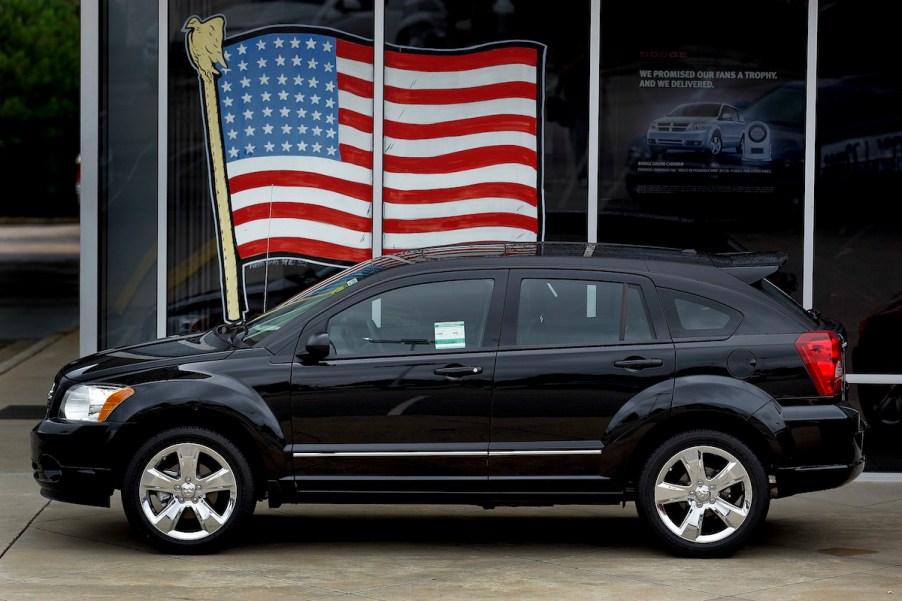
The 2009-2010 Dodge Journey Had the Worst Infotainment System Design of a 21st-Century Car
Some car models are retired for a good reason. One such vehicle is the Dodge Journey, which, upon introduction, was panned by automotive critics and consumers alike. Despite its low selling price, the Journey earned a bad reputation for several reasons, including notoriously poor reliability and handling and weak safety features. However, one of the more overlooked deficiencies of the Journey involved its subpar infotainment, which caused real safety problems for its drivers.
A brief look back at the Dodge Journey

If you’re unfamiliar with the Dodge Journey, this optional third-row SUV was first introduced in 2009. As per Cars.com, it started at just $20,925, was large, and had a relatively stylish exterior. It was also far from the best option on the market.
Dodge offered the 2009 and 2010 Journey with several configurations. The base model came with a 173-hp, 2.4-liter I-4 engine capable of generating 166 lb-ft of torque. But you could also purchase a 235-hp, 3.5-liter V-6 version with a six-speed automatic transmission, with SXT trims and higher. With the V-6, you get the third-row standard, but you don’t get as much power as other V-6 options in the segment.
The Journey offered fuel economy numbers that were average for SUVs its size. The I-4 got drivers 19 mpg in the city and 25 mpg on the highway, while the V-6 provided 16 mpg in the city and 23 mpg on the highway.
While the performance was average, handling wasn’t ideal. If you had to brake abruptly, you could expect discomfiting lurches to occur.
With a length of 192.4 inches and a height of 66.6 inches, the Journey offered plenty of cargo space and access, although the third row was more suited to children than adults. There were also some suitable storage spaces. However, the inclusion of a bin under the passenger seat was impossible to access while seated. It also prevented the inclusion of an airbag sensor, which is a safety hazard.
The 2009 and 2010 models were dinged for cheap interior trimmings that adversely affected ride comfort and enjoyment. Moreover, the base level trim lacked common advanced safety features in SUVs this size. As per Kelley Blue Book, the Journey only came with airbags, electronic stability, and electronic roll mitigation, not items like automated emergency braking or lane-keeping assistance.
The Journey’s terrible infotainment system
The Journey was also notable for an optional infotainment system that Jalopnik named one of the worst of all time—and with good reason. Of course, most SUVs have a built-in infotainment system, even if the touchscreen is small. But the Journey required an upgrade to have one installed in the base model, or else for you to purchase a higher trim level.
While the system was not intuitive, its voice commands helped ensure drivers could concentrate. But that feature was undermined by the placement of the screen. It was set below knee level, meaning drivers had to turn and look down to see what was being displayed. This awkward placement required drivers to take their eyes off the road, which could lead to accidents.
Oddly, if you purchased a Journey with the navigation feature, you’d see the map on a separate screen placed at the top of the dashboard, making it easier for drivers to follow directions. This proper placement further begs why the infotainment screen was placed below knee level rather than integrated at the top.
What happened to the 2009-2010 Dodge Journey?
The lukewarm reception the Journey received in 2009 and 2010 led Dodge to redesign the SUV. Kelley Blue Book notes that the 2011 Dodge Journey was much-improved, with more pleasant interior styling, responsive handling, and potent powertrain option. The 235-hp V6 was replaced by a 3.6-liter Pentastar version capable of generating 283 hp and better performance.
Unlike its predecessors, the 2011 Dodge Journey placed its infotainment screen at a more appropriate height, alleviating the safety hazard caused by the previous one. The higher-level trims offered an array of auto-tech amenities that made the 2011 Journey even more enticing.
Unfortunately, according to Autoblog, the 2011 Journey did not include any more advanced safety features as standard. But overall, the 2011 version was head and shoulders above its predecessor. Since those early days, the Dodge Journey has evolved even further, although not enough, according to many critics. It was eventually discontinued in 2020.
According to CarBuzz, a new 2022 model is being built exclusively for China. But don’t shed too many tears. Despite its substantive improvements over the years, the Dodge Journey still hasn’t been a top-tier offering in its segment.


